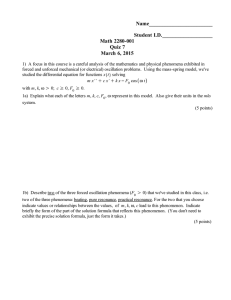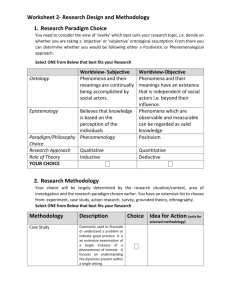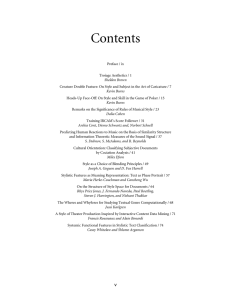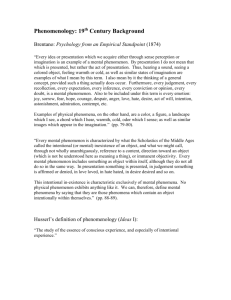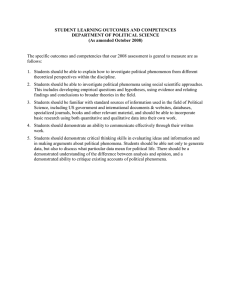Lucian Blaga, The Historical Phenomenon: An Excerpt from The
advertisement
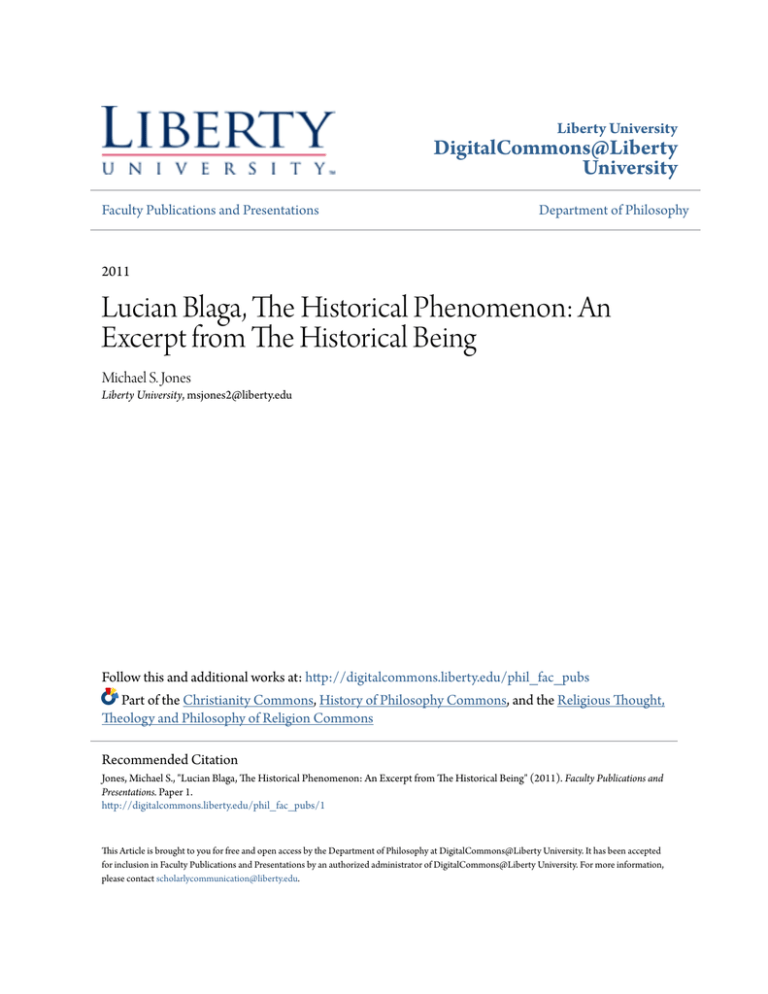
Liberty University DigitalCommons@Liberty University Faculty Publications and Presentations Department of Philosophy 2011 Lucian Blaga, The Historical Phenomenon: An Excerpt from The Historical Being Michael S. Jones Liberty University, msjones2@liberty.edu Follow this and additional works at: http://digitalcommons.liberty.edu/phil_fac_pubs Part of the Christianity Commons, History of Philosophy Commons, and the Religious Thought, Theology and Philosophy of Religion Commons Recommended Citation Jones, Michael S., "Lucian Blaga, The Historical Phenomenon: An Excerpt from The Historical Being" (2011). Faculty Publications and Presentations. Paper 1. http://digitalcommons.liberty.edu/phil_fac_pubs/1 This Article is brought to you for free and open access by the Department of Philosophy at DigitalCommons@Liberty University. It has been accepted for inclusion in Faculty Publications and Presentations by an authorized administrator of DigitalCommons@Liberty University. For more information, please contact scholarlycommunication@liberty.edu. Lucian Blaga, The Historical Phenomenon An excerpt from The Historical Being Translated by Michael S. Jones from the 1997 version published by Editura Humanitas in Trilogia Cosmologica. Translator’s Introduction This is a translation of the first half of the second chapter of Lucian Blaga’s book, The Historical Being. As far as I know, none of Blaga’s many volumes of philosophy have been published in English. It is my desire to publish an English translation of The Historical Being so that Englishspeakers can examine and enjoy Blaga’s philosophy. I have chosen this particular book for several reasons. Since it is one of Blaga’s later books, The Historical Being is more analytical, less speculative, and less poetic than are some of his earlier works, which is in keeping with the expectations and tastes of contemporary Analytic philosophers. At the same time, it deals with issues that interest Continental philosophers: the historical and contextual nature of beliefs, the social construction of “truth,” the existential situation of the individual vis-à-vis society, etc. Additionally, it provides a concise introduction to and summary of Blaga’s philosophical system, which is a significant bonus. The latter material may serve to stimulate interest in the rest of Blaga’s philosophy, and will help to locate his philosophy of history in its context within Blaga’s philosophical oeuvre. The chapter offered here has been selected for similar reasons. In this brief excerpt one sees Blaga’s thoughtful analysis of rival positions and his care to accurately portray the historical development of views without allowing a philosophical analysis to turn into a merely historical presentation. Furthermore, one can sense the development of a new position growing out of carefully nuanced distinctions that Blaga makes when discussing those who preceded him. The reader can see how Blaga is Continental in his concerns while being nearly Analytic in his method. Finally, in this excerpt the reader can catch a glimpse of Blaga’s philosophical system. When one views this chapter in the context of the whole book, one appreciates the systematic approach that Blaga takes to the issue of historical situatedness. Here is the table of contents of the book: Introduction 1. Concerning Historiography 2. The Historical Phenomenon 3. The Permanence of Prehistory 4. Organism and Society 5. Stylistic Fields 6. Styles and Dialectic 7. The Duration of Stylistic Factors 8. Stylistic Interferences 9. The Idea of Progress in History 10. Phenomena, Knowledge, Censorship Lines 11. Oswald Spengler and the Philosophy of History 12. The Metaphysics of History One can see that Blaga begins by defining terms, moves to deal with broad theoretical issues, narrows the focus, deals with potential objections and rival positions, and then closes with a suggested metaphysical position that compliments and completes his interpretation of the philosophy of history. Of course, not all of this can be seen in the fragment here translated. But hopefully a translation of the entire book will see the light of day within this decade! I would like to mention that Delia Ursulescu, my Graduate Assistant at Liberty University, has helped me to produce this translation, comparing my translation to the original and helping to resolve a number of phrases that were difficult to translate. Thank you, Delia! Michael S. Jones Let us proceed to the demarcation of the historical phenomenon in comparison to other phenomena. In what does the historicity of a phenomenon consist? What aspects and specific particularities distinguish historical phenomena from others? It has often been affirmed that historicity is a dimension of all natural phenomena that take place in space and time, including, naturally, psycho-spiritual phenomena. Historicity in this very general and diluted sense is confused with existence as a link in a rather temporal chain of events. According to some theoreticians, any concrete phenomenon that occurs in time, being an act that “becomes,” whether physical, biological, or psychological, may be seen in a historical perspective. In a similarly broad sense it would be possible to speak, for example, about the “history” of the sun and of the earth from their nebulous beginnings up to today. In the context of such considerations the observation has also been made that all phenomena, from the material to the spiritual, would be “singular” events, always individualized and irreversible. Temporality and singularity, individual and irreversible, were transformed into essential attributes of historical phenomena. There are several famous thinkers according to whom “historicity” consists in the serial occurrence in time of phenomena that are unique in their own way and that cannot be exactly repeated. The theoreticians that have adopted this perspective concerning the “history” of human acts and achievements do nothing but arbitrarily isolate a domain, a zone, in an area as vast as the world. In place of a qualitative and structural differentiation between “history” and “nature,” they merely carve out a sector in the framework of nature, doing so arbitrarily and without any logical justification. For our part, we believe that historicity is an attribute reserved to certain human phenomena (354) having a uniquely special structure – which is actually in agreement with the practice of historiography. Let us anticipate a little, so that we can move forward. We view historicity as a specifically human dimension, and it has its own structures that, although they “become” in time, cannot be confused with just any “becoming.” Therefore when it is a matter of the simple becoming of natural phenomena, whether physical, biological, or psychological, it would be good to resort to other terms. For the becoming of the planetary system, since this took place a single time in the universe, without a doubt the term “evolution” would be preferred, as likewise in the case when speaking about the “becoming” of certain animal species, for example the horse (from the phase when it had five toes on each foot and the size of a fox – until today). But even when we study the becoming of an individual human being, a becoming in itself incomparable and irreversible, this becoming can sometimes be the object of a “biography” without obtaining the distinction of a “historical” becoming. If historiographers have made for themselves a profession – often scientific and striving towards profundity – from the consideration of historical phenomena, it appears to us as that this has had at least the understanding that the historicity of human accomplishments is much more or even completely other than the becomings of nature or of the simple psychological biography. We were saying that the historical phenomenon was seen by some theoreticians as an individualized and irreversible temporal phenomenon, or otherwise stated, as a temporal phenomenon that is not repeated. Nonetheless things are not quite that simple. If individualization and irreversibility were to contribute decisively to the historicity of a phenomenon, it would be necessary to believe, and not merely in jest, that the most “historical” phenomena would be those apparitions that are “monstrous.” Let us suppose that somewhere in Tibet a woman would give birth to dectuplets the event would doubtlessly be a truly unique phenomenon, without match on our entire planet, but it will be conceded that this incomparable uniqueness does not invest this “inconsequential event” with the epitaph of historicity. On the other hand, we get the impression that there sometimes exist truly “historical” phenomena that are characterized precisely through the fact that they will not be unique and irreversible in the way in which they are configured. In the history (355) of Christianity, for example, were produced phenomena along the lines of “the imitation of Christ.” A certain saint attempted to relive, as much as possible, the life of Christ. Alexander the Great attempted in certain circumstances to repeat Achilles. Again, the Alps were crossed by a great many leaders of armies with the lucid consciousness of “repetition,” of a repetition that itself would confer on an act a historical significance. Therefore phenomena of a “historical” nature are recorded that have been consciously declared to have a fundamental tendency towards “repetition.” For the time being, therefore, we will specify that “historical” phenomena always take place concretely, somewhere and sometime, hic et nunc (in space and in time), but this does not mean that they are in all respects completely irreversible. In other words, in the domain of historical phenomena various grades of individualization and irreversibility are seen. Historicity doesn’t necessarily consist in “individualization” and “irreversibility.” A history exists that is realized through an explosion of individualizations (when a precise tendency exists in this sense), but a history also exists in the course of which is manifested a tendency towards repetition. We are permitted therefore to affirm that theoreticians like Windelband, Rickert, and Xenopol seem rather excessively attached to the aspect of individualization, irreversible and unforeseeable, when they introduce this aspect into the very essence of historicity. As befitting the earlier observation concerning a history that is manifest in individualizations and another history of which the hidden genius seems to consist precisely in the tendency towards repetition, we are not disposed to recognize more than grades of foreseeability or unforeseeability. Usually when a specific tendency appears in history, it tends towards the extreme: that which discerns this tendency can to some degree also anticipate certain historical phenomena that will be drawn upon the line of the foreseen tendency. For example, a tendency toward the dissolution of the classical forms and of certain norms of measurement and equilibrium appeared in the European spirit together with Romanticism. Given that these tendencies are apt to become accentuated, someone who would have had the necessary perceptiveness would have been able to anticipate that the process will eventually lead, after several decades, to (356) states of dissolution and total anarchy (for example, to Dadaism). In our opinion, different types of deeds and historical phenomena are possible. Repetition or the lack of repetition are not necessary to the essence of the historical phenomenon and do not constitute elements of its definition. Both are possible as secondary aspects, which is why history is presented in such varied forms, even as “genres” of history. However, we admit that the historical phenomenon is a singular deed that takes place here and now, but it is numerically singular, in other words it is concrete, and does not inevitably possess an irreversibly and an absolutely individualized configuration. Sometimes it might be possible for the phenomenon to have aspects that resemble other historical phenomena; in light of these resemblances, it would be possible for historical phenomena to signify a repetition. However, with all these considerations, we have done nothing but clear the field in view of a more adequate definition of the historical phenomenon. For the time being we are merely at the periphery. Another opinion has been suggested and has been adopted by a number of thinkers, that only those phenomena that have “significance,” that are the objectification of “values” or that have a rapport with values (aine Wertbezogenheit, as Rickert says) are “historical.” However, this definition also does not correspond exactly to the historical facts and the practices of the historiographers of which it is fitting to take notice. The proposed definition demands new explications and various modifications. For example, the purely psychological life of a human being is full of axiological references; it is connected to “values,” but such psychological moments do not always have a historical significance. Consider one such psychological moment that, although connected to a “value,” nonetheless does not through this become a moment of historical significance. An admirable natural vista, for example a Carpathian panorama, can arouse in any individual an intense state of ecstasy that finds expression in an esthetic appreciation. Nonetheless we do not really understand how this psychological-spiritual moment would in and of itself become a “historical” moment. Such a moment can become “historical” only if other completely unique moments appear in the same context. The psychological moment thanks to which a Romanian poet (357) composes a poem of sublime substance, a poem for which the Carpathian vista serves as the material that occasions the artistic/creative transfiguration, can be a “historical” moment. With this we have in truth drawn close, although only through an example, to the “historical” line. Dilthey was in the right neighborhood when he sustained that only the “objectification” of “experiences” truly deserves the epitaph of “historical phenomenon.” The great German philosopher bases his conception of history on the concept of “experience” (Erlebnis) and “objectification.” Dilthey’s explanations have had the effect of satisfying the theoretical exigencies of historiographers with experience of the living material. We will see, however, that his conceptualizations neither define nor sufficiently delimit “historicity.” In truth, the poem of the Carpathian poet could be, up to a point, the “objectification” of “experiences.” Nonetheless, this definition does not say very much, nor does it exhaust the essential aspects of poetry as a product of a creative act of historical character. The definition does not offer a criterion of historicity or of historical “dignity.” Why not? Because even as the simple linguistic exposition of a spiritual state caused by the vista is “objectification” of an “experience,” so too could the decision of a traveler to place in his home a photographic vista reproducing the vista that made such an impression on him indicate an objectification of an experience. Nonetheless, such objectifications of experiences remain neutral from the “historical” point of view. The simple “objectification” of “experiences” cannot be counted as a criterion of historicity, because in this case we cannot make any distinction between a historical phenomenon and one that is purely psychological-spiritual or restricted to biography. And in truth, Dilthey does not make much of a distinction. From this come the “psychological” flaws of his conception of history, on the one hand, and on the other, the “historical” flaws of his conception of psychological-spiritual life. Consequently Dilthey will maintain that psychology is the foundation of the historical sciences, just as mathematics is the foundation of the natural sciences; but the same Dilthey will maintain that the psychology of an individual cannot develop except in a historical medium. Through this confusion and osmosis between psychology and history, Dilthey annuls for himself the possibility of entering the land that (358) was promised to him and that he saw only from a distance, without the ability to discern its contours and configuration. For Dilthey, psychology and history are interconnected. One of the fundamental theses of our philosophy is the thesis concerning the two modes of human “existence.” The first of these concerns human existence in the horizon of the given world and in view of his/her self preservation (mode I), and the second concerns human existence in the horizon of mystery and in view of its revelation (mode II). Here we have a key that opens for us a way toward the concept of historicity. The two ontological modes, irreducible to each other even if they “communicate,” are distinguished from each other through the fact that for each mode the person is – in a structural way – otherwise equipped. In order to facilitate access to a definition of “historicity” it is necessary that we begin with specific anthropological analyses. The distinction between the two modes of human existence does nothing but describe the actual situation. There are psychological-spiritual phenomena that take place in the framework of mode I existence and there are phenomena of cultural creation, of the production of civilization, of social organization, that take place in the framework of mode II existence. Here, in the structural situation of the phenomena that take place in the framework of mode II existence, we must seek the nucleus of the concept of “historicity.” But the phenomena that take place in the framework of mode II are all characterized, without distinction, through the fact that they have a stylistic appearance. Consequently we will affirm that among the numerically singular concrete phenomena, only those that bear the imprint of “style” are historical. Through this stylistic seal that they bear, phenomena yield a special dignity and significance. But the style is owed to factors of a deep nature that contribute to the structure of the human being, and specifically to the factors that we name abyssal categories with their source of emanation in the unconscious human spirit. The stylistic (abyssal) categories, understood in their genuine state, not as concepts, but as patterning functions, are structured completely otherwise than the categories of the conscious mind. For example, the stylistic categories are imprinted on all cultural creations. (359) A natural phenomenon, whether of physics, biology, or psycho-spiritual in a restricted sense, never bears the imprint or brand of a style as long as the historical phenomena are preeminently characterized through these brands or stylistic facets. Therefore these stylistic categories that do not play any role in the constitution and characterization of natural phenomena, since they are not given, contribute in a decisive way, sine qua non, to the constitution and differentiation of historical phenomena. Hence the stylistic aspects become the symbols by which we distinguish a historical phenomenon from any other phenomenon. Historiography has as its object any chronospatial phenomenon that is numerically singular, concrete, and has stylistic structures or aspects; but all factors and moments that exist in the context of the appearance, duration, and demise of the phenomenon that bears a stylistic seal also pertain to the object of historiography. Historicity is therefore temporal existence (appearance, duration, disappearance) of a concrete phenomenon with a stylistic manifestation. With this statement we are affirming eo ipso that historicity is a dimension of phenomena that only appear in connection with human life. This is because only the human being, in distinction from all other beings, is endowed with the patterning functions of a stylistic nature. The complete human, the one who does not exist merely in the horizon of the given world, but also in the horizon of mystery (for revelation thereof) and who is structurally equipped with stylistic categories, the complete human is by definition the historical being. The notion of “historical being” and that of “complete human” are equivalents, synonyms. History begins, in other words, in the moment in which “the complete human” is declared. Prior to this, the human exists as an unfulfilled being; the human that throbs in the horizon of the given world is only distinguished from animal beings by degrees. The human as a historical being represents a leap or a mutation that is as much qualitative as it is of complexity in comparison to the human that lives merely in the horizon of the simple given world. We will perhaps be reproached saying that this delimitation, through which we demarcate the historical phenomena and the concept of historicity, depends too heavily upon an entirely unique theory of the structures of the human being. But we would not want to be accused of a dogmatism that we have never professed. For us this theory represents, (360) at least in this case, merely a set of orientative points of reference. Therefore we should attempt as much as is possible to strip this tentative definition of history of the apparatus that would seem too theoretical. Nonetheless, without theoretical considerations it is not possible to arrive at a philosophical analysis of historical phenomena and of the concept of historicity. Those who have followed the numerous studies of the philosophy of culture that we have published have certainly noticed that we have often striven to familiarize the readers with a number of phenomena that are characterized through stylistic aspects or details. We have usually proceeded by presenting the phenomenon: a work of art, a metaphysical vision, a myth, a theoretical construction in the domain of the history of the sciences, a specific religious state, and so forth. Then we seek to put in relief the style elements of the phenomenon presented. We circle in the vicinity of various details until it appears to us that we catch the essence that we then attempt to contain in speech, to formulate. Our passion does not usually diminish until we succeed in determining the stylistic aspects. It is a fact that phenomena that are susceptible to stylistic examination exist. To ascertain a phenomenon with stylistic aspects does not signify the creation of a “theory,” but rather it means to ascertain an event. It is true that discovering the stylistic aspects of a phenomenon, especially when this phenomenon is not concrete, visible with the eyes, is a fairly difficult thing. To see, to grasp, and then to formulate the stylistic aspects implicates a particular sensibility, an analytic power and synthetic intuition long practiced. But for those who possess this ability, the stylistic phenomena become “events” that are ascertained. Nevertheless, for the analysis and definition of historicity, the ascertainment in the framework of cosmic existence in general of various phenomena that are characterized, being distinguished from all others, through stylistic aspects, is sufficient. At the moment when we ascertain the existence of a great assembly of stylistic phenomena in the cosmic framework, we have an essential point of objective support for a discriminating examination in view of the definition of history and of historicity. It has been affirmed, as we have shown, that any phenomenon would be “historical,” not only in the framework of human life, but also the framework (361) of nature, in so far as it is viewed from the angle of temporality, of becoming, of temporal duration. It is clear that the temporal dimension enters into the definition of historicity, collaborating in the formation of the concept. But we have seen that we cannot form that complex meaning of “history” with which the historiography of humanity is occupied through temporality alone. If we would remain at a definition that is exclusively “temporal,” then any phenomenon becomes “historical.” The distinction between the historical phenomenon and a natural phenomenon is reducible to a simple distinction of perspective. The situation changes completely, however, the moment we discover a complete assembly of phenomena in the cosmic framework, which in an objective form is distinguished through its stylistic details that are not shared with the other phenomena. We have the impression that, in general, the practice of historiography corresponds precisely with a demarcation and definition of history in this sense: without temporality there is no history, but furthermore a historiography that refers to phenomena that do not involve style does not deserve the name. Certainly there are also theoretical considerations related to those stylistic aspects that are destined to demark the field of historical phenomena in the full sense of the word “history.” We should reduce, however, the “theory” of style to a minimum, so that, through the eventual fictions that arise, we don’t alter the stylistic events as such. The stylistic aspects of a phenomenon can be reduced to a number of independent but also convergent details. Explaining the stylistic phenomenon through “patterning functions,” specifics of the human spirit, certainly means to construct a “theory.” So it is. For the needs of the moment, therefore, we must reduce all of the theoretical apparatus to a minimum. This operation can be made in the following manner: any stylistic aspect, irreducible as such, we can attribute to a special factor that we name “stylistic determinant.” Since the stylistic phenomenon has a whole sum of irreducible stylistic factors, we can affirm that the phenomenon is pregnant with the influence of a number of stylistic determinants. If we imagine these determinants as vectors that exercise their influence over a phenomenon in the process of being produced, we are permitted to speak, at least (362) symbolically, about a “stylistic field” crisscrossed by a number of vectors. We are speaking of a “stylistic field” as one speaks about a magnetic field or a gravitational field in physics. We envision a phenomenon with stylistic features as taking place in a “stylistic field” crisscrossed by the lines of various determinants. With this we continue the simplification of the theoretical considerations related to the explanation of the stylistic phenomenon. Resorting to these means, we are able to attempt a concise definition of the historical phenomenon in distinction from other phenomena. It is certain that historiography views the object of research primarily from a “temporal” perspective, that is, from the angle of becoming and duration. It remains, however, to establish what specific objects or phenomena properly fall within the objective of historiography as befitting historiographical practice, namely what truly deserve to be counted as “historical phenomena.”
